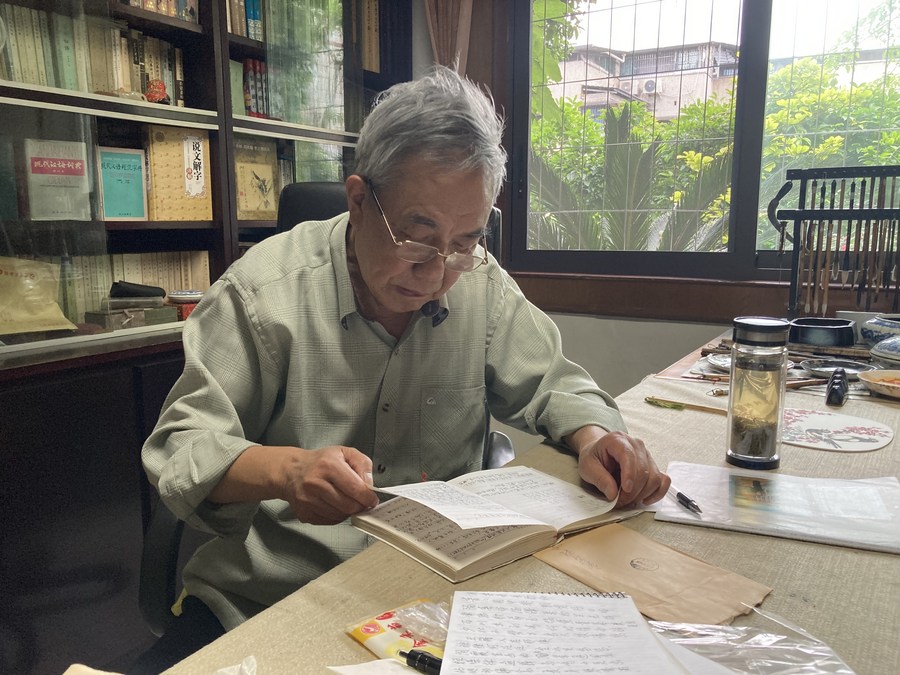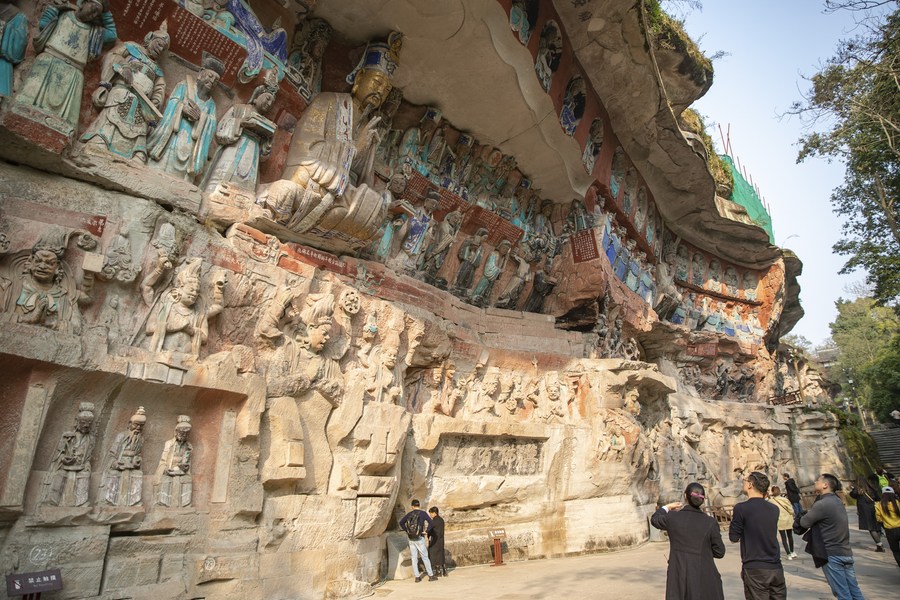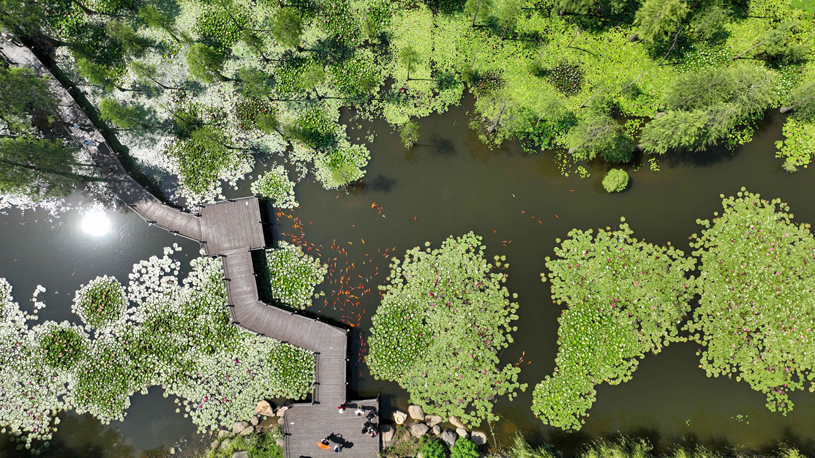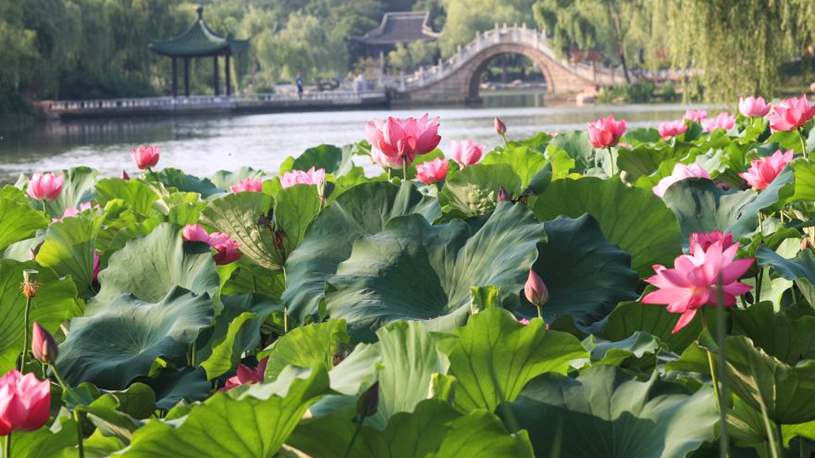
Guo Xiangying checks his notes on Dazu Rock Carvings in southwest China's Chongqing, April 25, 2022. (Xinhua/Liu Enli)
CHONGQING, June 27 (Xinhua) -- From remote counties in China to far-flung corners of the world, 86-year-old Guo Xiangying has been on the move throughout his career.
His efforts have been for one purpose: conserving and popularizing more than 50,000 rock carvings dating back between the 9th and 13th centuries, which lie in the grottoes of Dazu District, southwest China's Chongqing Municipality.
"At first, I didn't like the carvings that much. But later, I saw them as my lifeline. This sense of devotion was cultivated through a long period of loneliness," he said.
Guo, a conservator at the Dazu Rock Carvings UNESCO World Heritage site and the first president of the Chongqing Art Museum of Dazu Rock Carvings -- now the Academy of Dazu Rock Carvings -- has been protecting the site for nearly five decades.
Born and raised in Chongqing, he was admitted to a secondary teachers' school in Dazu County, now Dazu District. After graduating, he learned traditional Chinese realistic painting techniques and worked as an art teacher in different primary schools for 10 years.
Guo was 37 when he began developing a passion for ancient carvings.
It was in 1974 that Guo came to work in the county cultural relics depository.
Although the carvings were already listed among the key cultural relics sites under national-level protection, many locals in the city didn't know that Dazu was home to such treasures.
More than 50,000 statues are scattered across 75 sites in Dazu. They are mostly concentrated on Baoding Mountain, Beishan Mountain, Shizhuan Mountain, Nanshan Mountain and Shimen Mountain.
Guo was dispatched to Beishan in 1974. Upon receiving the notice, he packed all his belongings and left for the mountaintop.
After he arrived, he realized that things were different from how he had expected them to be. There was no electricity or running water nearby -- he didn't even have a neighbor. "I had to wait for rainy days so that I could carry and store up to 100 kg of water at a time for everyday use."
Instead of feeling sorry for himself, he decided to make most of the opportunity. He took about six months to settle in, drilling wells, growing vegetables, planting trees and patrolling the area to prevent vandalism and theft. "Even though life was bitter, I felt happy to be accompanied by the noble works of art."
As time went by, his primary focus switched from patrolling to exploring the carvings. He thought about how the stone carvings were chiseled and what the stories behind the relics were. He devoured books in search of answers.
In 1980, the National Cultural Heritage Administration launched a project to build archives for national cultural relics units, with filing image data becoming an indispensable component of this work.
Without a camera or professional surveying and mapping personnel, Guo volunteered to help file the site by sketching. Without measurement apparatus, he crafted and repaired tools by himself.
When measuring statues over 20 meters in height, he would tie colored strips of cloth to the end of a rope, with red representing one meter and white representing half a meter.
Guo led a busy life. He measured the statues during the day and sketched images under a kerosene lamp at night. His nostrils were blackened by the smoke.
Two paintings of the carvings were finished two years later, measuring a total of over 40 meters in length and featuring more than 10,000 statues.

Tourists visit the Dazu Rock Carvings scenic spot in southwest China's Chongqing, Feb. 23, 2021. (Xinhua/Huang Wei)
The site gradually gained fame. Many tourists from home and abroad visited the site, so did academic experts.
"Many officials and experts had said for years that we needed to make the carvings 'go global,' but in what way could we achieve this aim?" Guo said.
A conversation gave him his direction. In 1987, Guo first heard about the World Heritage List while chatting with relics protection professionals. He learned from them that the carvings had been included on a preliminary world heritage declaration list drafted by the National Cultural Heritage Administration.
In 1990, Guo established the Chongqing Art Museum of Dazu Rock Carvings.
To fully prepare for the application, he visited and studied almost all the major grottoes across China. "After comparison, I found that the Dazu carvings have distinctive features, integrating Confucianism, Buddhism and Taoism with Chinese folk culture."
And with the help of city and county-level governments, the foul-smelling pools, cluttered stalls and heavily polluted pigpens in the site were renovated.
These joint efforts paid off. In December 1999, the Dazu Rock Carvings were listed on UNESCO's World Heritage List following several rounds of assessment, becoming the second grotto world cultural heritage site in China after the Mogao Grottoes.
According to the UNESCO website, the Dazu Rock Carvings are remarkable for their aesthetic quality, their rich diversity of subject matter, both secular and religious, and the light that they shed on everyday life in China during this period. They provide evidence of the harmonious synthesis of Buddhism, Taoism and Confucianism.
After returning to China, he continued with his conservation efforts.
Guo retired in 2003, but has since been stationed near the site, conducting research on the statues, teaching classes and authoring books.
In 2007, one of the site's best-known Buddhist statues, an 800-year-old sculpture of bodhisattva Qianshou Guanyin with some 1,000 hands, was found to have suffered severe erosion and weathering. The statue's color had faded, some of its gold foil covering had peeled off, cracks had appeared and part of the statue's fingers had fallen off.
He joined a team of experts from across China to draft customized restoration plans for the statue after thorough research. It took the team nearly eight years to restore the work, utilizing various materials and some 440,000 pieces of gold foil.
"People engaged in cultural relics work should not only think about the present, but also the future, so that our future generations can see these relics," he said.
Following Guo's retirement, others have taken the baton and marched ahead.
"We will further improve the site's protection, perfect its monitoring and early warning system to ensure the safety of the Dazu statues, and continue to tell their stories," said Li Fangyin, president of the Academy of Dazu Rock Carvings. ■












